After a long, sad decline, a traditional fisherman’s soup is undergoing a renaissance.
Feri Kocsis is a man of few words and fewer ingredients. The chef at Rév Csárda in Érsekcsanád, a village in southern Hungary, Kocsis arranges slices of carp in the bottom of a black cauldron around the fish’s severed head. Its dead eye stares up at a wet September sky. Kocsis is an ethnic Hungarian from the Serbian village of Bezdan who has spent 20 years making halászlé, a riverside soup traditionally made by fishermen from the day’s catch over a driftwood fire. He adds finely chopped onions and a dash of salt. He hauls in two jugs of water from his kitchen and pours it over the fish. He brings the cauldron to a shack whose inner black walls are lined with geometrically arranged stacks of firewood that extend in towering blocks all the way to a dirt road where a man with an ax is at work.
Inside, a fire pit lines one of the shack’s walls and Kocsis works on building a small fire. The wood has been drying for six months and it catches like magnesium. He hoists the cauldron and suspends it on a chain over the open flames. “This is how fishermen have always made halászlé and this is how it will always be made, at least as long as I’m around,” he says.
A few steps from his shack, concealed by a row of black poplars, the gray-green Danube snakes toward Serbia, where a million refugees and migrants are making their way towards Hungary. The 100-mile border between the two countries is the most convenient entry point into the European Union’s borderless Schengen Area.

It may be how Kocsis makes halászlé, this most intense and certainly the most authentic of Hungarian soups, but his craft is a dying art. Before 2012, when Rév Csárda was founded on the grounds of an old fisherman’s pub, its small dining area now decorated with fishing nets and owner Gábor Tinusz’s charming family photos, the only way you could eat authentic halászlé was by making it yourself.
Nothing sums up the malaise better than a recent article in which Tamás B. Molnár and Dóra Bittera, the messianic husband-and-wife team of food writers who have done more than anyone to rescue Hungarian cuisine from cynicism and vegetable shortening, had to resort to describing Kocsis’ halászlé, whose name means “fisherman’s soup,” as “fisherman style fisherman’s soup.” You know you’re in trouble when a riverside soup traditionally made by fishermen can be any other style than fisherman style.
In a few minutes the cauldron has come to a violent boil. Kocsis tops the froth with paprika, his fifth and last ingredient. It imbues the soup with a glow to echo the poplar flames. Every few minutes, Kocsis takes a J-shaped stick of driftwood—its business end black with soot, its handle worn smooth—and gives the cauldron a spin to prevent the carp’s fins from catching on its inner wall. Every few minutes, Kocsis feeds the fire to keep the flames high.
“The fish is cooked in 12 to 15 minutes, but halászlé needs to be kept on the boil for another 20 for the collagen to escape the bones and thicken the soup,” he says.
When it’s almost done he slips milt and a roe sac into the soup. He takes a sip from a tasting spoon. “No need to adjust,” he says. “It’s not a complicated thing to make.”
The soup looks primordial, deep red in a cauldron the color of deep space.
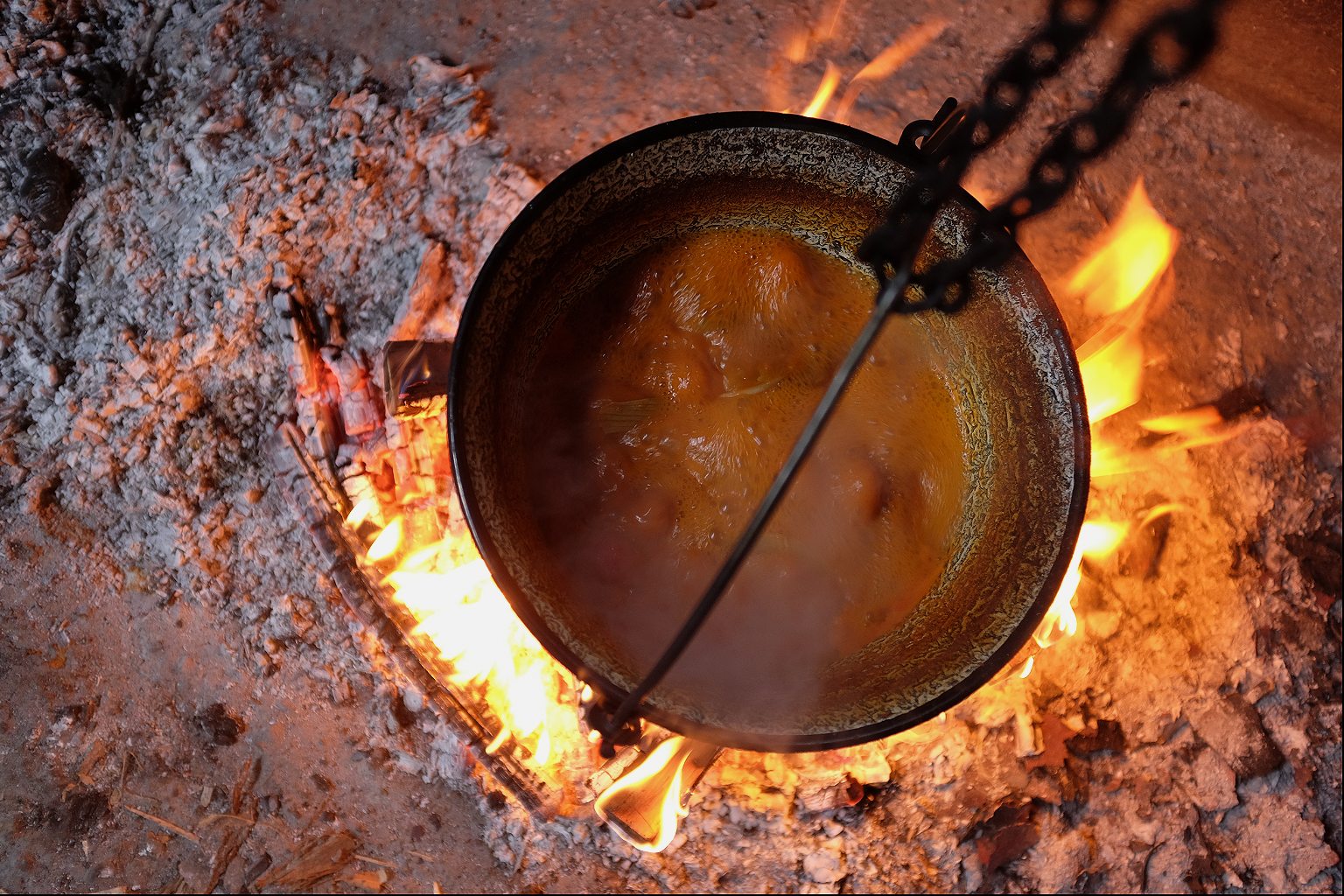
Hungary was once Europe’s fish powerhouse. The country’s two great rivers, many smaller rivers, wetlands, billabongs, and alluvial plains supported a cuisine built on a freshwater bonanza.
Halászlé, cooked from farmed carp these days, used to be made from wild river carp. In the second half of the 19th century, vast armies of day laborers went to work on the Danube and its fickle main tributary the Tisza to tame their meandering courses and limit floods. By the turn of the century, hundreds of miles had been chopped off the two rivers, which were now confined within high banks. The alluvial plains were converted into safe farmland, bends in the rivers diminished into oxbow lakes. The river’s endless forests of pedunculate oak, black poplar, and white willow, teeming with red deer and black storks and wild boar, were reduced to tatters.
The floods were gone but so was most of what had made Hungarian cuisine exceptional. Hungary’s four decades of communism—no friend of the culinary arts—dealt the final blow. Halászlé was no longer fisherman style. It became the gray, microwaved, swampy dreck served all over the country. The only remaining traditional halászlé could be found in the town of Baja in southern Hungary, its neighboring villages like Érsekcsanád, and in Gemenc—one of the last remaining patches of alluvial forest on the Danube—where people refused to give in and continued to make halászlé the way it had always been made.
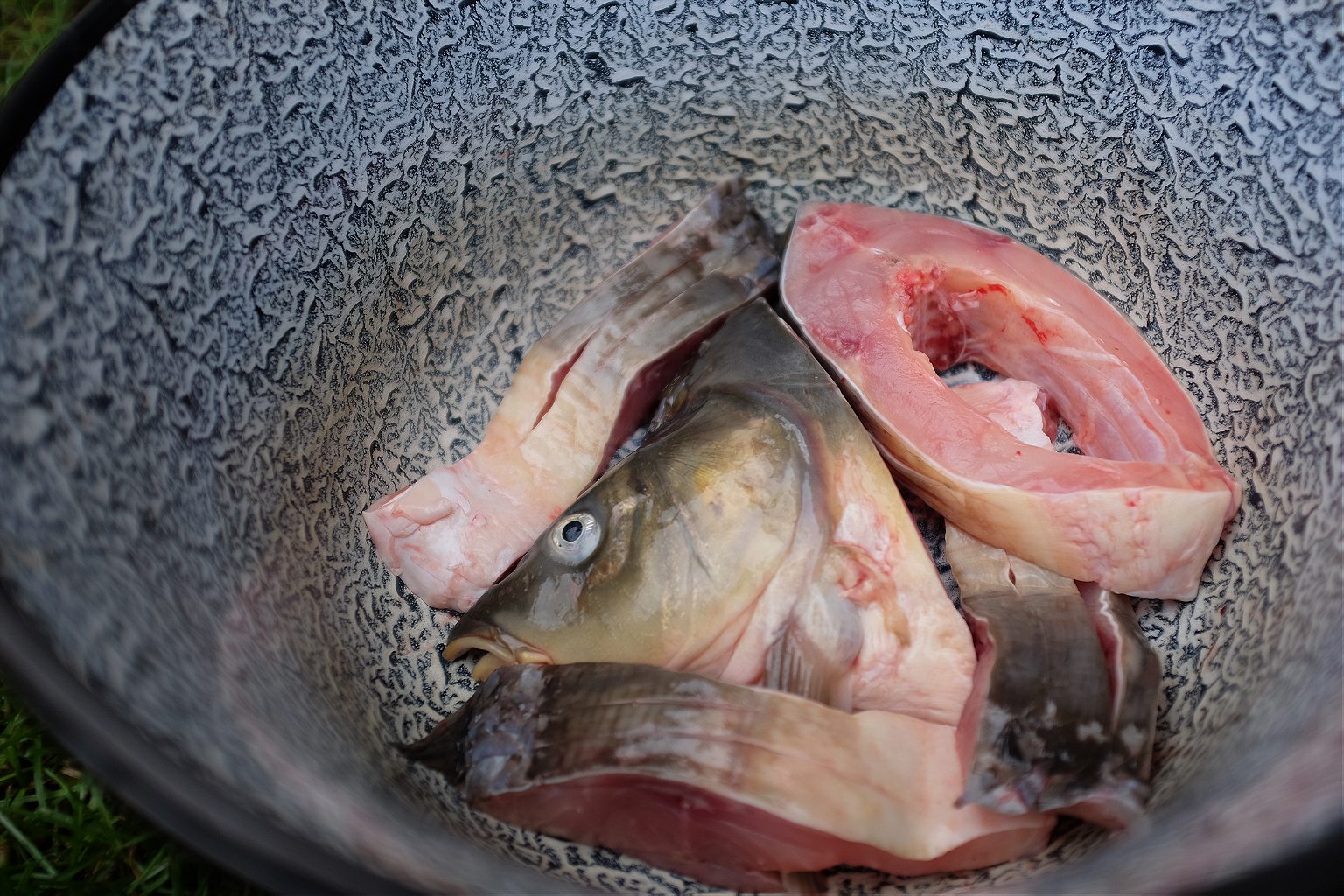
In the early 1960s, my father, an up-and-coming Budapest geneticist with a penchant for madcap kayaking trips, washed up on the shores of Gemenc. It was love at first sight. He kept coming back to walk its humid depths. He watched the red deer engage in their autumnal rutting fights after they’d spent the summer sucking pounds of calcium from their own bones to grow their elaborate antlers, and he wondered why their skeletons didn’t shatter from osteoporosis. This is now his research.
He also learned to make halászlé. When I was four he bought a fishing cabin, and there we spent summers that felt endless. I learned to read by asking the names of river barges and cruise ships. There was no power, no plumbing, nothing but the river and the forest, red deer and black storks and wild boars.
HALÁSZLÉ IS UNIQUELY UNSUITED TO BE RESTAURANT FOOD
I never learned how to make halászlé, but I learned to obsess over it. You have to eat it right away. You ladle the soup over chewy egg noodles similar to those in certain East Asian noodle soups except cut into spoon-size pieces. Done right—and at Rév Csárda it is invariably done right—halászlé is a supernova of highlights and undertones around a core of sweet paprika and sweet fish. It may be a noodle soup but in its minimalism, its obsessive focus on ingredients, its deceptive simplicity, and its unpretentious origins, the dish it best resembles is sushi.
Except halászlé is uniquely unsuited to be restaurant food. It has to be made to order over an open fire. It takes the better part of 45 minutes to prepare. It can only be made in small batches. It requires constant attention while cooking.
In restaurants this workingman’s dinner turns into a fancy hipster meal. Gábor Tinusz, who opened Rév Csárda in 2012, charges $10 per head, with a minimum order of two, in a country where $5 will buy a perfectly decent bowl of ramen in downtown Budapest. It’s fairly ludicrous until you see the sheer amount of care and effort halászlé takes and then you realize why it’s so tempting to cheat, which explains the inedible halászlé served everywhere else in Hungary. You also wonder how Rév Csárda can make it as a business.
For Tinusz, preserving authentic halászlé is a labor of love. A real estate developer from Baja, a town of 37,000 built on a bend in the Danube, where everyone is raving mad about halászlé, he refurbished an old fisherman’s pub five miles up the river, opposite my father’s fishing cabin, and hired Feri Kocsis as his chef. Kocsis had recently moved to Hungary from Serbia and was baking pizza in a Baja restaurant.
Tinusz’s timing was perfect. Baja’s halászlé crowds may have been indifferent, but Hungary’s online food scene was exploding. People started making the 200-mile round trip from the capital. Before long, I was bumping into Budapest friends a mile from my childhood forest hideaway. In three years, Rév Csárda has become a shining star of rural Hungarian dining. Tinusz observed our very empty cauldron with a smile. The last drops of an afternoon shower pattered against the roof.
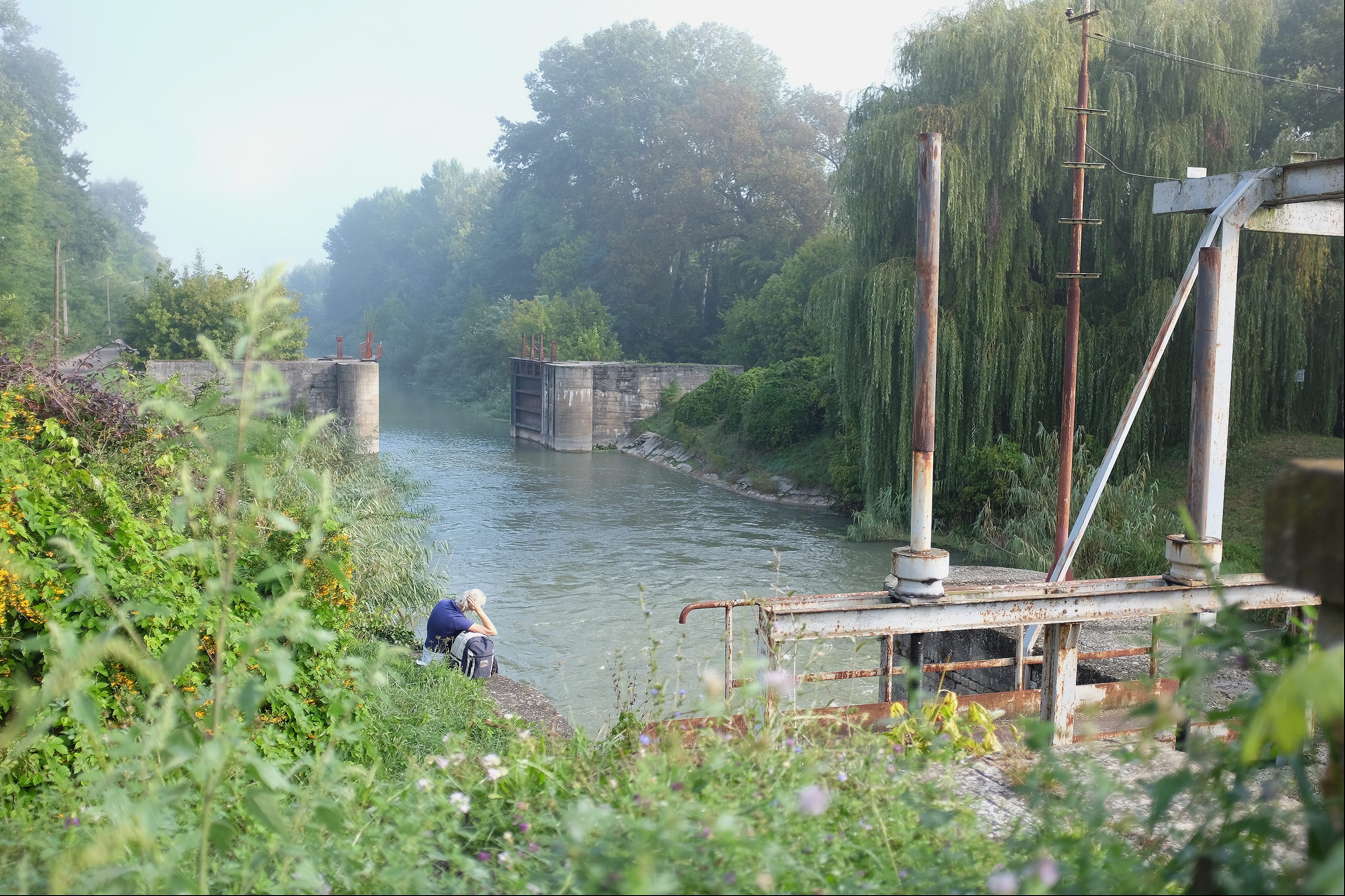
“Pet minuta,” a man says outside our tent. Sluggish from sleep, I mumble something in reply. “Five minutes,” he repeats in English.
After our dinner of halászlé the day before yesterday, my wife Natalie and I walked 30 miles south, into Serbia, across a border recently strung with three coils of razor wire to keep refugees out of Hungary. We camped on the outskirts of Bezdan, the hometown of Rév Csárda’s Feri Kocsis. We are here to eat halászlé at Čarda Pikec. I climb out of the tent.
In the cotton candy mist of a pink September morning, a gaunt man leans against his scythe, regarding me with his one eye the color of Cherenkov radiation. I greet him in Hungarian. He breaks into a smile and explains, in Serbian-accented Hungarian, that he is terribly sorry to disturb our sleep but he’ll need five minutes to harvest fresh alfalfa for his pigs. This he proceeds to do. He invites us to snack on his plum trees for breakfast and offers coffee. “Kids, have a safe trip!” he shouts when he spots us later on the street.
In a watery maze of canals, on a road lined by the columns of white poplars planted in Empress Elisabeth of Austria’s day, we walk out of Bezdan to rejoin the Danube. A Serbian policeman, built like a combat vehicle and far more relaxed than the Hungarian police who stopped us several times yesterday, pulls over and asks for ID in perfect Hungarian.
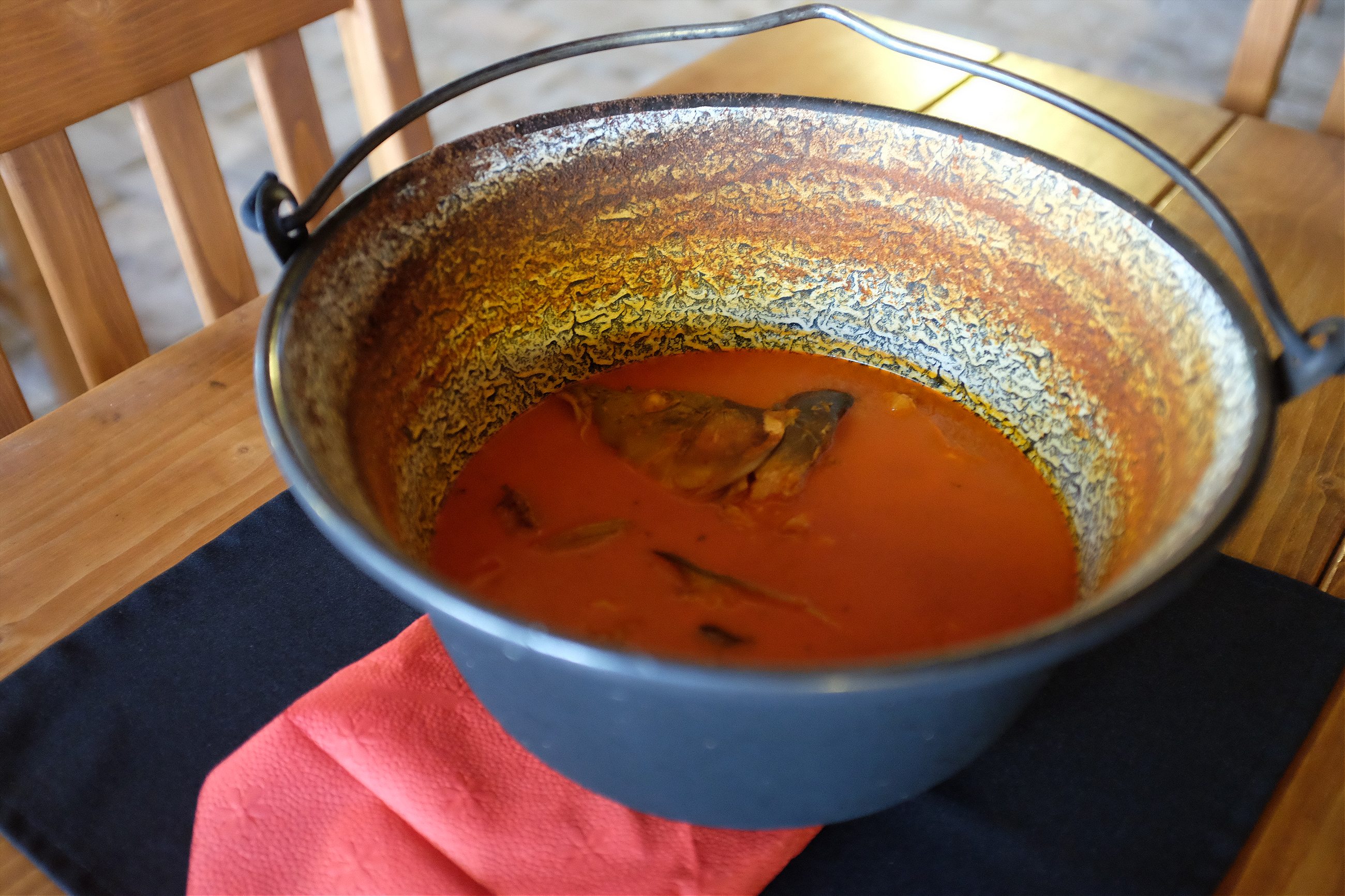
Čarda Pikec stands on a spit of land at the end of a street of vacation homes. The view is breathtaking and international. In a dazzle of kaleidoscopic plumage a kingfisher flies out of the forest and perches on a fishing net in plain view of the dining area. The white houses of Batina line the Croatian bank. Ducks gather on the shore.
“Ducks are no good,” András, Čarda Pikec’s head waiter, says. “Ducks mean summer is over for good.” But summer begs to differ. We dry our tent in the hot sun on a pier, which extends into the Danube–Tisza–Danube Canal and which contains a cage of carp waiting to be slaughtered for halászlé.
Pikec opened in 1990, just before Yugoslavia shattered, and it has developed an underground cult following during the years when it was impossible to get good halászlé in Hungary. For a single meal of soup, Hungarians in the know would make the 60- to 300-mile round trip across an international border to Pikec and describe the experience in loving detail. It was not without reason. In a tumultuous quarter century Pikec hasn’t lowered its standards. The restaurant feels less like Rév Csárda’s meticulous recreation of a vanished culture than an artifact of old Hungary’s fish world.

Like at Rév Csárda, the halászlé at Čarda Pikec is made on order. Chef Ivan Jager adds a teaspoon of tomato paste to the soup and explains that other chefs prefer a dash of white wine. Like ragù alla bolognese, the proper way of making halászlé morphs from village to village, from csárda to čarda, from Hungary to Serbia, hacks and milt and tricks and roe embellishing the five-ingredient core. The name changes, too: Here, we’re eating riblji paprikaš, which translates to “fish stew with paprika” instead of “fisherman’s soup,” but is otherwise the same dish. In 35 minutes, the cauldron is off the flames and on our table, peeling flakes of soot and metal.
Čarda Pikec’s soup of sweet fish and sweet paprika makes a mockery of nationalism. This pride and joy of Hungarian cuisine, available in a single restaurant in Hungary, is now served by a Serbian chef and a Hungarian waiter on a table with a view of Croatia. It is among the best I’ve ever eaten. It is a soup of the borderlands, of a borderless river culture, a soup equally Hungarian, Serbian, and Croat, a soup whose signature spice is from Mesoamerica.
On our way towards the bridge between Serbia and Croatia, the Serbian policeman built like a combat vehicle waves goodbye from his squad SUV.
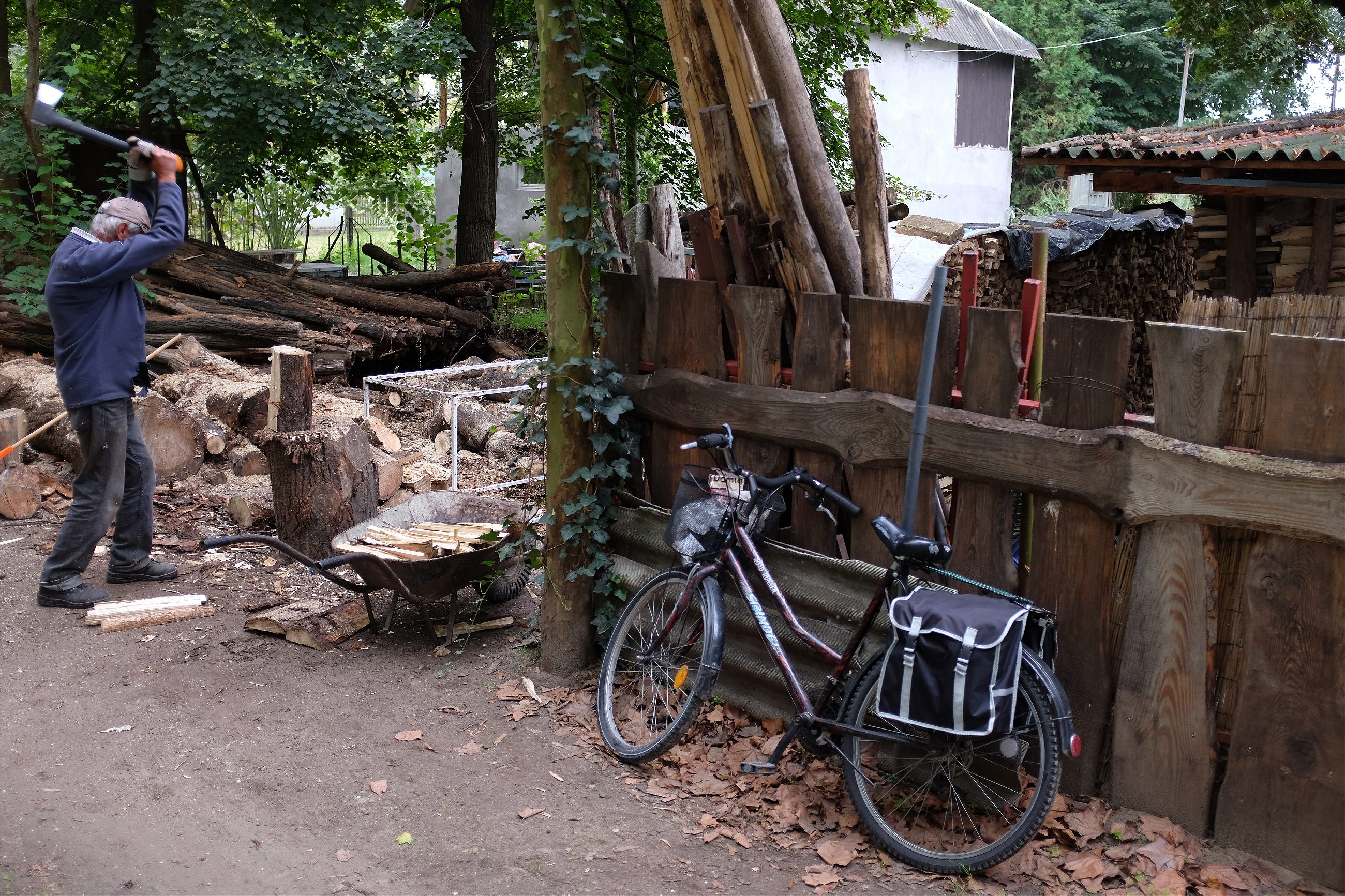
“Why don’t you have kids?”
The sun is relentless in a metallic white sky above parched cornfields. We’re in Croatia now. I tell Ivan—not Čarda Pikec’s chef but a 12-year-old Croatian boy on a bike with a thousand questions—that it’s complicated.
“But why don’t you have kids?”
Across the bridge into Croatia, the land changes, the misty alluvial forests of the Serbian bank replaced by rolling loess hills of fruit orchards and vineyards. Long villages butt up against the loess walls, their main streets dotted with pink Art Nouveau houses.
We have halászlé in Kovač Čarda, in Suza, which is entirely different. It is cooked over a gas flame and is so brutal on the paprika that it resembles maeuntang, the Korean soup made from the leftover parts of fish served raw. We sit outside, with a view over fields and a distant line of black poplars that hide the river and the Czech political joke of Liberland, another unintended consequence of 19th century river management.
“Take him to bed! Go to a sperm bank!”
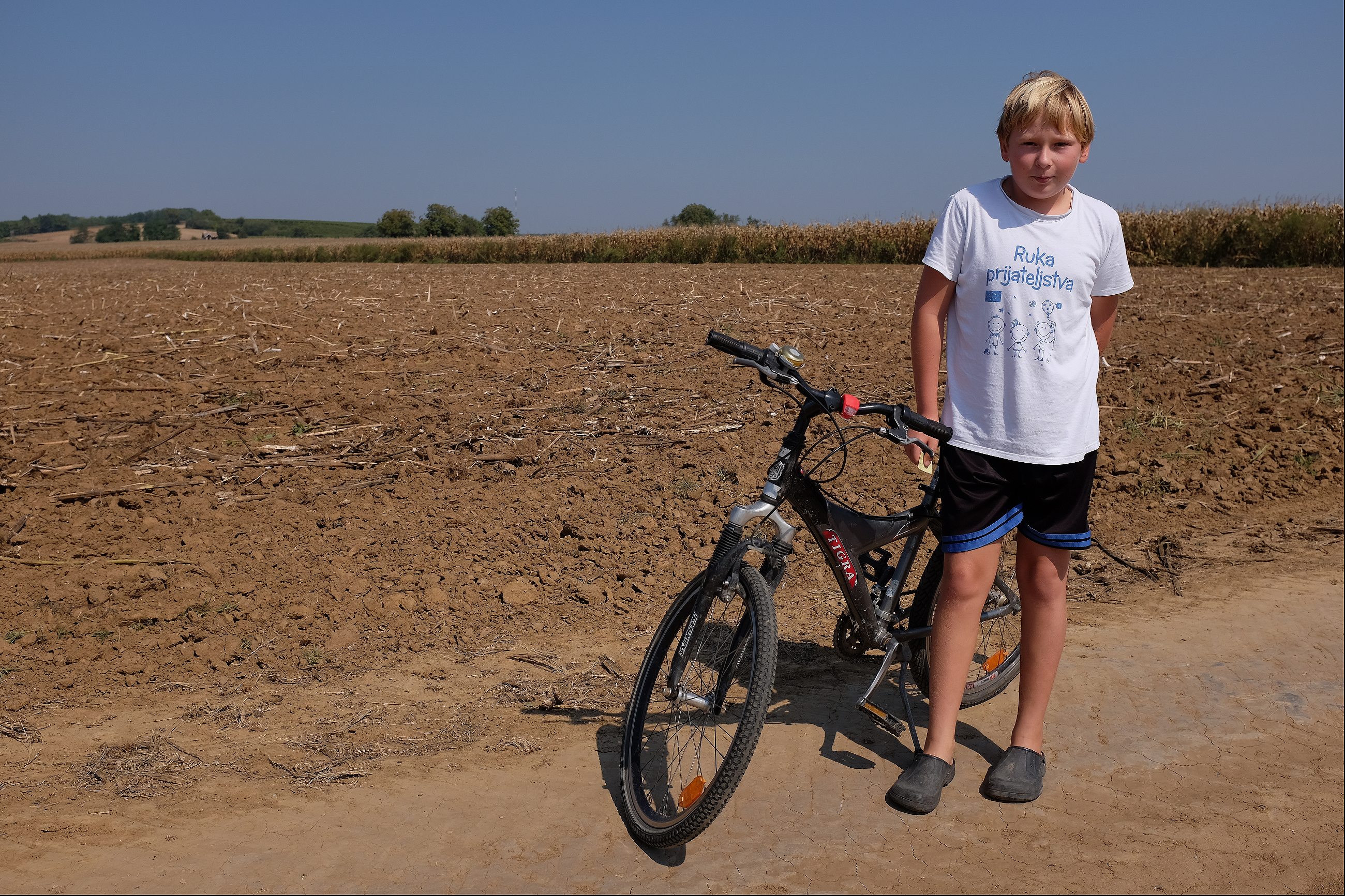
Ivan, this young man of relentless reproductory advice, lives three miles from Kotlina, a village on the Croatian loess plateau where my father was born during World War II, the son of a Hungarian Reformed pastor from Budapest. His church, one of three in a village of 250, stands on the top of a hill in a field of roses growing semi-wild.
We are welcomed into the parsonage by Melinda, the current pastor’s wife, who feeds us potato chips and wine for breakfast. She digs through an ancient cupboard, overflowing with church documents that date back to the 18th century, and produces ledgers from my grandfather’s time.
In the courtyard of the parsonage, a halászlé cauldron hangs from the low branch of a tree. When I tell Melinda about our journey, she nods and says that her husband Darko uses it for meat stews instead of halászlé. They’re no fans of fish. We say our goodbyes. After 60 miles on foot, we board the day’s only train home. It’s empty except for us and a grandmother. Across a field dotted with white willows, the train crosses an invisible European Union border, the dream of an entire world out there, to Hungary.